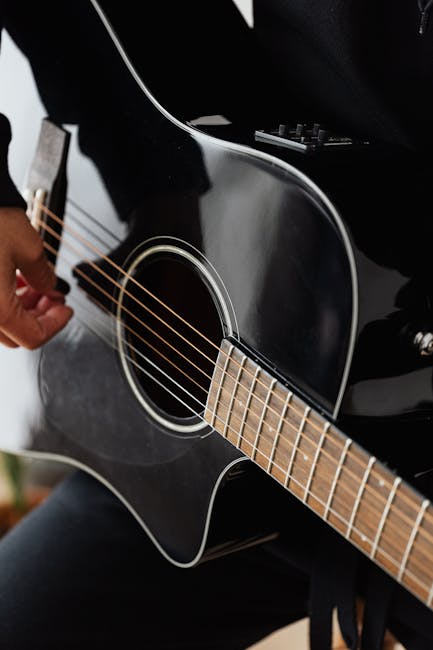Are your fingers feeling a little flat when it comes to playing guitar? Do you find yourself stuck in a musical rut, strumming the same old chords like a broken record player? Fear not, fellow guitar enthusiasts! It’s time to ditch the air guitar and elevate your playing to new heights. Get ready to rock and roll with our tips and tricks for taking your guitar skills to the next level. It’s time to move from amateur strummer to six-string superstar! Foundation: Mastering Basic Guitar Techniques”>
Foundation: Mastering Basic Guitar Techniques”>
Contents
- 1 Understanding the Foundation: Mastering Basic Guitar Techniques
- 2 Exploring the Fretboard: The Art of Navigation and Note Identification
- 3 Rhythmic Precision and Strumming Patterns: Enhancing Your Timing and Feel
- 4 Theoretical Insights: Integrating Music Theory into Practical Playing
- 5 Creative Experimentation: Incorporating Improvisation and Composition
- 6 Expanding Your Repertoire: Learning and Interpreting Songs Across Genres
- 7 Seeking Feedback and Continuous Learning: Embracing Constructive Criticism and Practice Strategies
- 8 FAQs
- 9 Rock On!
Understanding the Foundation: Mastering Basic Guitar Techniques
So you’ve decided to pick up the guitar and join the ranks of rockstars and folk heroes alike. But before you can shred like Hendrix or fingerpick like Dylan, you’ve got to master the basics. We’re talking about the foundational techniques that will set you up for success on the six-string wonder.
First up, let’s talk about proper finger positioning. Your fingers are going to be doing a lot of the heavy lifting, so it’s crucial to place them in the right spots on the fretboard. Make sure your fingers are arched and pressing down on the strings with just the right amount of pressure. No limp noodles here!
Next, let’s tackle strumming patterns. Rhythm is key in guitar playing, so get comfortable with different strumming patterns. Experiment with upstrokes and downstrokes, and don’t be afraid to get a little funky with it. Before you know it, you’ll be grooving like a pro.
And of course, we can’t forget about chord transitions. Moving smoothly from one chord to another can be a challenge, but with practice, you’ll get the hang of it. Start slow, focus on accuracy over speed, and soon enough, you’ll be switching chords like a seasoned pro. Remember, Rome wasn’t built in a day, and neither is guitar mastery!

So you’ve picked up the guitar and are ready to conquer the fretboard like a true rockstar, but where do you even begin? Fear not, my fellow aspiring shredders, for I am here to guide you through the mystical world of fretboard navigation and note identification.
First things first, let’s talk about the basics. The fretboard is like a musical map, with each fret and string representing a different note. It’s kind of like a game of “Where’s Waldo”, but instead of a bespectacled man in a striped shirt, you’re looking for notes.
One handy trick for navigating the fretboard is to memorize the notes on the 6th and 5th strings. These two strings are your best friends when it comes to finding your way around the neck. Start by memorizing the notes on the 5th fret of each string:
- 6th string: A
- 5th string: D
Once you’ve got those down, you can use them as reference points to find other notes on the fretboard. It’s like having breadcrumbs to lead you out of the musical forest of confusion.
 Strumming Patterns: Enhancing Your Timing and Feel”>
Strumming Patterns: Enhancing Your Timing and Feel”>
Rhythmic Precision and Strumming Patterns: Enhancing Your Timing and Feel
So, you want to level up your guitar game, huh? Well, you’ve come to the right place! Let’s talk about rhythmic precision and strumming patterns – the key to enhancing your timing and feel.
First off, let’s talk about the importance of having impeccable timing. It’s like being the drummer of the band, but with strings instead of sticks. Without good timing, you might as well be playing a kazoo in a jazz band – it just won’t work. So, tighten up those strings and get ready to groove!
Next up, let’s dive into different strumming patterns. Sure, you could stick to the basic down-up strumming, but where’s the fun in that? Experiment with different patterns like down-down-up-up-down-up or down-up-down-up-down-up. Mix it up, get funky, and watch your playing go from zero to hero!
Remember, practice makes perfect. Spend some quality time with your guitar, jamming out to your favorite tunes and experimenting with different rhythms. Before you know it, you’ll be strumming like a rockstar with the timing of a metronome. So, grab that guitar, unleash your inner musician, and let’s get strumming!
 Playing“>
Playing“>
Theoretical Insights: Integrating Music Theory into Practical Playing
Have you ever found yourself feeling lost in a sea of musical notes, desperately trying to make sense of it all? Well, fear not, because we have some theoretical insights that will help you navigate the treacherous waters of musical theory!
By integrating music theory into your practical playing, you can unlock a whole new world of possibilities. But don’t worry, we won’t bog you down with complex equations or mind-numbing jargon. Instead, we’ll break it down into simple concepts that will help you understand the music you’re playing on a deeper level.
One key insight to bear in mind is understanding the relationship between different musical scales and how they can be used to create tension and resolution in your playing. By mastering the art of scale degrees and intervals, you can add a whole new depth to your music that will have your audience hanging on every note.
Furthermore, don’t forget about the importance of chord progressions in your playing. By understanding how chords work together within a key, you can create smooth transitions and add a sense of cohesion to your music. So next time you’re jamming out, think about the power of chord progressions and watch your playing reach new heights!
Creative Experimentation: Incorporating Improvisation and Composition
Are you tired of following the same old rules when it comes to creating music? Do you want to break free from the constraints of traditional composition? If so, it’s time to embark on a journey of creative experimentation. By incorporating improvisation and composition, you can unlock a world of endless possibilities and explore new ways of expressing yourself through music.
One way to start experimenting is to blend improvisation with traditional composition techniques. Try writing a basic melody or chord progression, and then improvise around it to see where it takes you. You never know what unexpected twists and turns you might discover along the way. Mix up your creative process and see what new sounds you can come up with.
Don’t be afraid to embrace the unexpected. Allow yourself to make mistakes and take risks in your music-making. Sometimes the most magical moments come from spontaneous decisions and happy accidents. Let go of your inhibitions and let your creativity flow freely. Who knows, you might stumble upon a masterpiece in the making.
Remember, the key to successful creative experimentation is to have fun and enjoy the process. Don’t put too much pressure on yourself to create something perfect. Embrace the chaos, go with the flow, and see where your musical journey takes you. Who knows, you might just surprise yourself with what you are capable of creating.
Expanding Your Repertoire: Learning and Interpreting Songs Across Genres
Ready to take your musical prowess to the next level? It’s time to expand your repertoire by learning and interpreting songs across various genres. Whether you’re a pop princess, a rock god, or a jazz aficionado, there’s something for everyone to explore in the world of music.
Don’t be afraid to step out of your comfort zone and try your hand at a new genre. Who knows, you might discover a hidden talent or a new favorite song along the way. Plus, mastering different genres will make you a more versatile and well-rounded musician in the long run.
From classic rock anthems to soulful R&B ballads, the possibilities are endless when it comes to expanding your song repertoire. Embrace the challenge and get ready to wow your audience with your diverse musical abilities.
So grab your instrument of choice, dust off your vocal chords, and get ready to embark on a musical journey like never before. Remember, music is the universal language that knows no boundaries. Let your creativity soar as you learn and interpret songs across genres with confidence and flair!
Seeking Feedback and Continuous Learning: Embracing Constructive Criticism and Practice Strategies
Have you ever received feedback that made you want to curl up in a ball and cry? Don’t worry, we’ve all been there! But instead of taking it personally, why not embrace constructive criticism as a way to improve yourself and your skills?
Think of feedback as a gift (albeit sometimes a slightly unwanted one) that can help you grow and develop. So, next time someone tells you that your presentation was a snooze-fest or your dance moves need some serious work, take a deep breath, thank them for their input, and start thinking about how you can make improvements.
Continuous learning is all about pushing yourself out of your comfort zone and trying new things. So, whether it’s learning a new language, taking up a new hobby, or mastering a new skill, don’t be afraid to challenge yourself. Practice makes perfect, after all!
Remember, Rome wasn’t built in a day, so be patient with yourself and keep pushing forward. Before you know it, you’ll be the one giving out feedback and encouraging others to embrace constructive criticism and practice strategies!
FAQs
What are some unconventional ways to improve my guitar skills?
Well, have you tried playing your guitar with a banana instead of a pick? Who knows, you might discover a new technique that revolutionizes the music industry!
How can I break through a plateau in my playing?
Have you considered taking a break and binge-watching guitar tutorials on YouTube? Sometimes a little inspiration from others can reignite your passion for playing!
What should I do if I feel overwhelmed by the amount of techniques and theory to learn?
Why not start a band with your pet goldfish? They may not be able to play guitar, but they can definitely provide some emotional support during your practice sessions!
How do I stay motivated to practice even when I feel discouraged?
Maybe you just need to switch things up a bit. Have you tried playing your guitar in a different room? Or dressing up in a funky costume while you practice? It’s all about keeping things interesting!
Rock On!
Congratulations, you’ve made it to the end of our guide on how to elevate your guitar skills! Remember, Rome wasn’t built in a day, and neither will your guitar mastery be. Keep practicing, keep learning, and most importantly, keep rocking out! With these strategies in your arsenal, there’s no limit to how far you can go with your guitar playing. So grab your guitar, turn up the volume, and let the music take you to new heights. Who knows, maybe one day you’ll be headlining at Madison Square Garden! Keep strumming, keep shredding, and most importantly, keep being awesome. Rock on!



